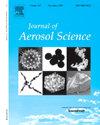Size-resolved chemical composition analysis of ions produced by a dielectric barrier discharge bipolar charger
IF 2.9
3区 环境科学与生态学
Q2 ENGINEERING, CHEMICAL
引用次数: 0
Abstract
Accurate prediction of aerosol charge distribution is crucial for aerosol size distribution measurements using electrical mobility spectrometers. The charge distribution of widely used bipolar diffusion aerosol charging is affected by the electrical mobility and mass of ions. In this study, we developed and evaluated a concentric cylindrical double dielectric barrier discharge (DBD) bipolar charger, and investigated the impact of measurement conditions on electrical mobility and mass of charging ions. The size-resolved chemical composition of ions produced by the DBD charger was analyzed using a high-resolution half-mini differential mobility analyzer coupled to an atmospheric pressure interface time-of-flight mass spectrometer. The effects of the discharge gas, carrier gas and relative humidity (RH) on ion properties were evaluated. Our results show that both discharge gas and carrier gas influenced the chemical composition of ions. The detected high-abundance ions were mainly originated from impurities in the carrier and discharge gases, or compounds used when manufacturing the system components. The ion mobility distribution varied with the type of carrier gas and its relative humidity, but was not sensitive to discharge gas or its flowrate. The measured charge distribution using the DBD charger was in a good agreement with Wiedensohler's approximation (Wiedensohler, 1988), and the theoretically predicted charge distribution, calculated from the measured ion properties, was also consistent with the experimental results. Only minor variations with a relative uncertainty of 12.1% and 9.5% for positive and negative particles, respectively, in singly charged particle fractions were expected among different measurement conditions. Despite a higher uncertainty likely introduced by using ambient air as the carrier gas, our work indicates that the newly developed DBD charger has the potential to be used as a bipolar charger under typical laboratory and ambient measurement conditions.
介质阻挡放电双极充电器所产生离子的尺寸分辨化学成分分析
气溶胶电荷分布的准确预测是至关重要的气溶胶大小分布测量使用电迁移谱。广泛应用的双极扩散气溶胶充电的电荷分布受电迁移率和离子质量的影响。在这项研究中,我们开发和评估了同心圆柱形双介质阻挡放电(DBD)双极充电器,并研究了测量条件对充电离子的电迁移率和质量的影响。利用高分辨率半微型差分迁移率分析仪与大气压界面飞行时间质谱仪耦合,分析了DBD充电器产生的离子的尺寸分辨化学成分。考察了放电气体、载气和相对湿度对离子性能的影响。结果表明,放电气体和载气对离子的化学组成都有影响。检测到的高丰度离子主要来源于载体和放电气体中的杂质,或制造系统组件时使用的化合物。离子迁移率随载气类型和载气相对湿度的变化而变化,但对载气和载气流量不敏感。使用DBD充电器测量的电荷分布与Wiedensohler的近似(Wiedensohler, 1988)非常吻合,并且根据测量的离子性质计算的理论预测的电荷分布也与实验结果一致。在不同的测量条件下,单电荷粒子组分中正、负粒子的相对不确定度变化较小,分别为12.1%和9.5%。尽管使用环境空气作为载气可能会带来更高的不确定性,但我们的工作表明,新开发的DBD充电器在典型的实验室和环境测量条件下具有用作双极充电器的潜力。
本文章由计算机程序翻译,如有差异,请以英文原文为准。
求助全文
约1分钟内获得全文
求助全文
来源期刊

Journal of Aerosol Science
环境科学-工程:化工
CiteScore
8.80
自引率
8.90%
发文量
127
审稿时长
35 days
期刊介绍:
Founded in 1970, the Journal of Aerosol Science considers itself the prime vehicle for the publication of original work as well as reviews related to fundamental and applied aerosol research, as well as aerosol instrumentation. Its content is directed at scientists working in engineering disciplines, as well as physics, chemistry, and environmental sciences.
The editors welcome submissions of papers describing recent experimental, numerical, and theoretical research related to the following topics:
1. Fundamental Aerosol Science.
2. Applied Aerosol Science.
3. Instrumentation & Measurement Methods.
 求助内容:
求助内容: 应助结果提醒方式:
应助结果提醒方式:


